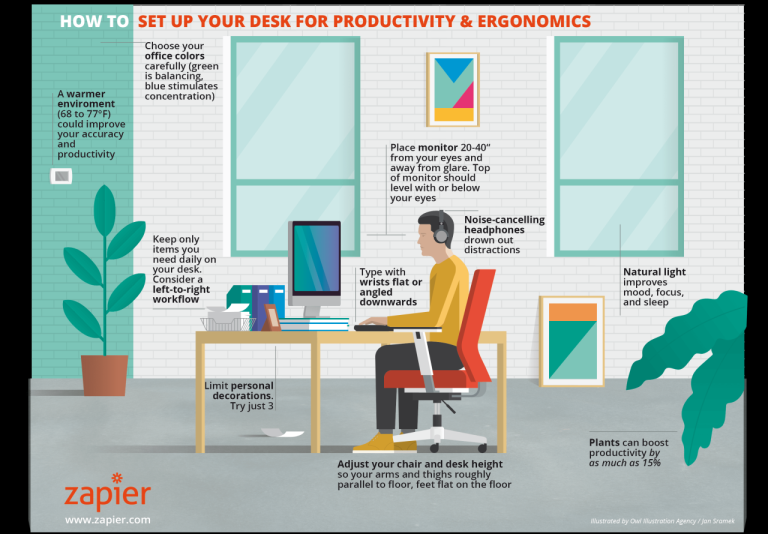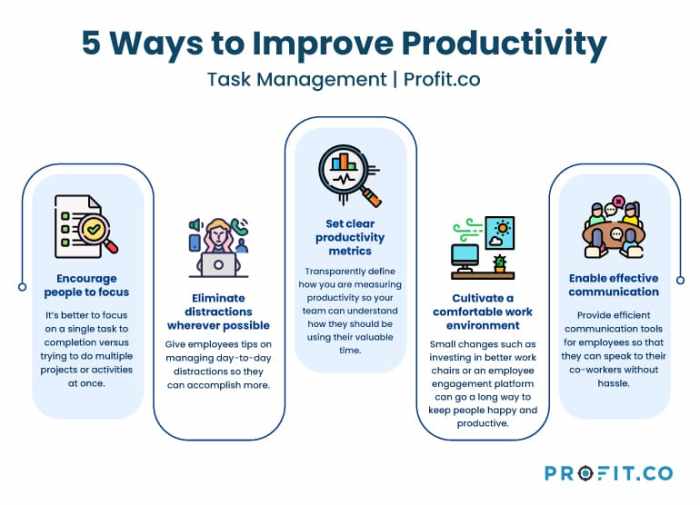
Imagine waking up feeling energized and focused, ready to tackle your day with a clear plan and a sense of purpose. This is the power of a structured morning routine. By establishing a consistent set of habits and activities, you can optimize your productivity and unlock your full potential. This routine becomes your secret weapon for a more fulfilling and successful day.
In this guide, we’ll explore the benefits of a structured morning routine, learn how to design one that fits your individual needs, and discover key habits that can boost your productivity. We’ll also discuss strategies for maintaining consistency and adapting your routine as your life evolves.
The Importance of a Structured Morning Routine

Starting your day with a structured routine can significantly boost your productivity and overall well-being. A well-defined morning routine sets the tone for the rest of your day, helping you achieve more and feel better.
Benefits of a Structured Morning Routine
A structured morning routine offers numerous advantages, including:
- Increased Productivity: By establishing a consistent routine, you eliminate decision fatigue, allowing you to focus on your most important tasks early in the day when your energy levels are typically highest. This leads to greater efficiency and accomplishment.
- Reduced Stress: A predictable morning routine creates a sense of control and order, reducing anxiety and promoting a calmer start to the day. Knowing exactly what to do and when helps minimize stress and allows you to approach your day with a more relaxed and focused mindset.
- Improved Focus: By dedicating specific time slots for tasks like meditation, exercise, or reading, you train your brain to focus on the task at hand. This enhances your concentration and makes it easier to stay on track throughout the day.
- Enhanced Mood and Well-being: Engaging in activities that nourish your mind and body, such as exercise, healthy eating, or journaling, sets a positive tone for the day, boosting your mood and promoting a sense of well-being. This, in turn, enhances your overall productivity and satisfaction.
Examples of How a Structured Routine Can Help
Imagine waking up each morning with a clear plan. You start with a short meditation session, followed by a brisk walk, a nutritious breakfast, and a review of your daily goals. This routine creates a sense of calm and focus, allowing you to tackle your tasks with renewed energy and clarity. By establishing this structure, you reduce the chances of feeling overwhelmed or scattered, leading to a more productive and fulfilling day.
Contributing to a More Positive and Fulfilling Day
A structured morning routine sets the stage for a positive and fulfilling day. It helps you prioritize your well-being, giving you a sense of control and accomplishment. This positive momentum carries over into your work, relationships, and personal life, allowing you to live a more balanced and satisfying life.
Designing Your Ideal Morning Routine
Designing a morning routine that works for you is a personalized process. It’s not about copying someone else’s routine but finding what aligns with your goals, preferences, and lifestyle.
Key Elements to Consider
When designing your ideal morning routine, there are several key elements to consider.
- Your Goals: What do you want to achieve with your morning routine? Do you want to be more productive, reduce stress, improve your health, or simply feel more energized?
- Your Time Constraints: How much time do you realistically have in the morning? Be honest with yourself about your schedule and don’t overcommit.
- Your Energy Levels: Are you a morning person or a night owl? Tailor your routine to your natural energy levels.
- Your Preferences: What activities do you enjoy doing in the morning? What are your non-negotiables?
Potential Activities to Include
Here’s a list of potential activities you can include in your morning routine:
- Exercise: A morning workout can boost your energy, mood, and focus. Even a short walk or jog can make a difference.
- Meditation or Mindfulness: Taking a few minutes to quiet your mind can help reduce stress and improve your mental clarity.
- Breakfast: Eating a nutritious breakfast can provide your body with the energy it needs to start the day.
- Planning: Setting your intentions for the day can help you stay focused and productive. This could include making a to-do list, reviewing your calendar, or setting goals.
- Reading: Reading something inspiring or informative can set a positive tone for your day.
- Gratitude Practice: Taking time to appreciate the good things in your life can boost your mood and overall well-being.
- Personal Care: This could include showering, getting dressed, or doing your hair and makeup.
Sample Morning Routine Schedule
Here’s a sample morning routine schedule that you can adapt to fit your own needs:
| Time | Activity |
|---|---|
| 6:00 AM | Wake up, drink a glass of water |
| 6:15 AM | Exercise (30 minutes) |
| 6:45 AM | Shower and get dressed |
| 7:00 AM | Meditation or mindfulness (10 minutes) |
| 7:10 AM | Breakfast (20 minutes) |
| 7:30 AM | Plan your day (15 minutes) |
| 7:45 AM | Review your calendar and emails |
| 8:00 AM | Start your workday |
Essential Habits for Productivity
A structured morning routine is a powerful tool for enhancing productivity, but it’s the habits you integrate into it that truly make the difference. These habits are not just about ticking off tasks but about cultivating a mindset that sets you up for success throughout the day.
Prioritizing Tasks and Setting Realistic Goals
Before diving into your tasks, it’s crucial to prioritize them effectively. This involves identifying the most important activities that will move you closer to your goals.
- Start by listing all the tasks you need to accomplish that day.
- Then, categorize them based on urgency and importance using the Eisenhower Matrix.
- Focus on the urgent and important tasks first, as these are the ones that will have the biggest impact on your progress.
- Don’t be afraid to delegate or postpone tasks that are less critical.
Setting realistic goals is equally important. Instead of aiming for ambitious targets that might overwhelm you, focus on smaller, achievable milestones. This approach fosters a sense of accomplishment and keeps you motivated.
“Don’t aim at success – aim at significance.”
Henry David Thoreau
Incorporating Mindfulness and Gratitude Practices
Mindfulness and gratitude practices can dramatically enhance your morning routine and overall productivity.
- Mindfulness involves paying attention to the present moment without judgment. This can be as simple as taking a few deep breaths and noticing your surroundings or engaging in a brief meditation session.
- Gratitude practices involve focusing on the positive aspects of your life. This could include expressing appreciation for your loved ones, your health, or even something as simple as a cup of coffee.
These practices help to calm the mind, reduce stress, and increase focus, creating a more positive and productive start to your day.
Tips for Consistency and Adaptability
A structured morning routine can be a powerful tool for boosting productivity, but sticking to it consistently can be challenging. Consistency is key, but flexibility is equally important. Here’s a guide to help you create a morning routine that works for you and stay on track:
Strategies for Maintaining Consistency
It’s crucial to build habits that help you stay consistent with your morning routine. Here are some effective strategies:
- Start small: Don’t try to overhaul your entire morning routine overnight. Instead, start by adding one or two new habits and gradually build from there. For example, you could begin by waking up 15 minutes earlier and incorporating a short meditation session.
- Make it a non-negotiable: Treat your morning routine as a commitment to yourself. Schedule it in your calendar and prioritize it like any other important meeting or task.
- Create a visual reminder: Post a reminder of your morning routine on your bathroom mirror, fridge, or somewhere else you’ll see it every day. This visual cue can help you stay on track.
- Build in accountability: Share your morning routine goals with a friend or family member, or join an online group for support and motivation. Having someone to check in with can help you stay accountable.
- Reward yourself: Acknowledge your progress and reward yourself for sticking to your routine. This positive reinforcement can help you stay motivated.
Adapting Your Morning Routine
Your morning routine should evolve with you. As your needs and preferences change, so should your routine.
- Reflect on your goals: Regularly assess your goals and priorities. If your goals have shifted, your routine may need to be adjusted accordingly.
- Experiment with different activities: Don’t be afraid to try new things in your morning routine. If something isn’t working for you, try something else.
- Consider your energy levels: Pay attention to your energy levels throughout the day. If you find yourself feeling sluggish in the afternoon, try adjusting your morning routine to include activities that energize you.
- Embrace flexibility: Life is unpredictable, and there will be times when you need to adjust your routine. Don’t be afraid to deviate from your plan when necessary.
Overcoming Challenges
It’s natural to face challenges when trying to establish a new habit.
- Identify the roadblocks: Take some time to reflect on what’s preventing you from sticking to your routine. Are you struggling with motivation, time constraints, or lack of sleep?
- Adjust your routine: Once you identify the roadblocks, adjust your routine to address them. For example, if you’re struggling with time constraints, try waking up a little earlier or streamlining your morning activities.
- Be patient and persistent: It takes time to build new habits. Don’t get discouraged if you slip up occasionally. Just pick yourself up and get back on track.
- Celebrate your successes: Recognize your progress and celebrate your successes, no matter how small they may seem. This positive reinforcement can help you stay motivated.
Productivity Beyond the Morning Routine

A structured morning routine is not just about setting yourself up for a productive day; it’s about establishing a foundation for a productive life. The habits and principles you cultivate in the morning can be applied to other areas of your life, creating a ripple effect of positive change.
Extending Morning Routine Principles
The principles of a productive morning routine, such as prioritizing, setting clear goals, and fostering mindfulness, can be applied to other aspects of your day and life. This can include:
- Work: Prioritize tasks based on their importance and urgency, schedule breaks throughout the day, and maintain focus during work sessions.
- Relationships: Schedule quality time with loved ones, engage in active listening, and practice empathy and understanding.
- Personal Development: Dedicate time for learning, pursuing hobbies, or engaging in activities that contribute to your personal growth.
Understanding Productivity
Productivity is often perceived as simply getting things done, but a deeper understanding reveals a more nuanced definition. True productivity involves working efficiently and effectively towards meaningful goals, leading to a sense of fulfillment and accomplishment. It’s about prioritizing tasks that align with your values and aspirations, rather than just ticking off items on a to-do list.
Aligning Work with Personal Values and Goals
Understanding your values and goals is crucial for achieving true productivity. When your work aligns with your personal aspirations, you are more likely to find it fulfilling and motivating. This alignment fuels your intrinsic drive, making it easier to stay focused and engaged. For instance, if your value is personal growth, you might prioritize projects that allow you to learn new skills or expand your knowledge.
If your goal is to build a successful career, you might focus on tasks that contribute to your professional development.
“Productivity is never an accident. It is always the result of a commitment to excellence, intelligent planning, and focused effort.”Paul J. Meyer
The Concept of “Flow State” and Its Role in Productivity
The “flow state,” a concept popularized by psychologist Mihaly Csikszentmihalyi, is a state of complete immersion and focus in an activity. When you are in flow, you lose track of time, feel energized, and experience a sense of deep satisfaction. Flow state is often associated with optimal productivity because it allows you to work at your peak performance. To enter a flow state, you need to find activities that challenge you but are not overwhelming.
This involves finding the sweet spot between boredom and anxiety, where you are fully engaged and motivated.For example, a writer might experience flow when they are deeply engrossed in their writing, a musician might achieve flow during a captivating performance, and a programmer might enter flow while solving a complex coding problem.
A structured morning routine is more than just a list of tasks; it’s a powerful tool for cultivating a positive mindset, enhancing your focus, and setting the stage for a productive day. By incorporating mindfulness, gratitude, and intentional planning into your mornings, you can unlock a sense of calm and control that will ripple throughout your day. Remember, the key is to find a routine that aligns with your values and goals, allowing you to harness the power of a productive morning for a more fulfilling life.
Question & Answer Hub
What if I don’t have time for a morning routine?
Even a short, 15-minute routine can make a difference. Start small and gradually add activities as you find your groove.
How do I stay motivated to stick to my routine?
Focus on the benefits you’ve experienced, celebrate your progress, and make adjustments as needed to keep things engaging.
What if I miss a day or two?
Don’t beat yourself up. Just get back on track as soon as you can. Consistency is key, but perfection isn’t.
What are some good resources for creating a morning routine?
There are many books, articles, and podcasts on the topic. Look for resources that resonate with your personal style and goals.



